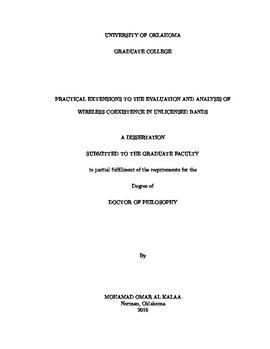| dc.description.abstract | Sharing spectrum resources in unlicensed bands has proven cost effective and beneficial for providing ubiquitous access to wireless functionality for a broad range of applications. Chipsets designed to implement communication standards in the Industrial, Scientific and Medical (ISM) band have become increasingly inexpensive and widely available, making wireless-enabled medical and non-medical devices attractive to an increased number of users. Consequently, wireless coexistence becomes a concern. In response, the U.S. Food and Drug Administration (FDA) has issued a guidance document to assist medical device manufacturers ensure reasonable safety and effectiveness. Coexistence-testing methods are now being reported in literature, and novel solutions are under consideration for inclusion in the American National Standards Institute (ANSI) C63.27 Standard for Evaluation of Wireless Coexistence.
This dissertation addresses practical issues for evaluating and reporting wireless coexistence. During testing, an under-test-system (UTS) is evaluated in the presence of an interfering system (IS). Accordingly, an innovative method is suggested for estimating channel utilization of multiple, concurrent wireless transmitters sharing an unlicensed band in the context of radiated open environment coexistence testing (ROECT). Passively received power measurements were collected, and then a Gaussian mixture model (GMM) was used to build a classifier for labeling observed power samples relative to their source. Overall accuracy was verified at 98.86%. Case studies are presented utilizing IEEE 802.11n as an IS with UTS based on either IEEE 802.11n or ZigBee. Results demonstrated the mutual effect of spectrum sharing on both IS and UTS in terms of per-second channel utilization and frame collision.
The process of approximating the probability of a device to coexist in its intended environment is discussed, and a generalized framework for modeling the environment is presented. An 84-day spectrum survey of the 2.4 GHz to 2.48 GHz ISM band in a hospital environment serves as proof of concept. A custom platform was used to monitor power flux spectral density and record received power in both an intensive care unit (ICU) and a post-surgery recovery room (RR). Observations indicated that significant correlation in activity patterns corresponded mainly to IEEE 802.11 channels 1, 6, and 11. Consequently, channel utilization of three non-overlapping channels of 20 MHz bandwidth---relative to IEEE 802.11 channels 1, 6, and 11---were calculated and fitted to a generalized extreme value (GEV) distribution. Low channel utilization (< 10%), along with sporadic occurrences of higher channel utilization (> 50%), was observed in the surveyed environment. Reported findings can be complementary to wireless coexistence testing.
Quantifying the probability of UTS coexistence in a given environment is central to the evaluation of coexistence, as evidenced in the draft of the C63.27 standard. Notably, a method for this calculation is not currently provided in the standard. To fill this void, the work presented herein proposes the use of logistic regression (LR) to estimate coexistence probability. ROECT was utilized to test a scenario with an 802.11n IS and ZigBee UTS medical device. Findings demonstrate that fitted LR model achieves 92.72% overall accuracy of classification on a testing dataset that included the outcome of a wide variety of coexistence testing scenarios. Results were incorporated with those reported in [1] using Monte Carlo simulation to estimate UTS probability of coexistence in a hospital environment. | en_US |
